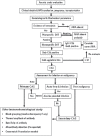Clinical and serological characterization of cold agglutinin syndrome in a Tertiary Care Hospital in Eastern India
- PMID: 26420939
- PMCID: PMC4562140
- DOI: 10.4103/0973-6247.154258
Clinical and serological characterization of cold agglutinin syndrome in a Tertiary Care Hospital in Eastern India
Abstract
Background and aim: Cold agglutinin syndrome (CAS) primary or secondary represents approximately 16-32% of autoimmune hemolytic anemia cases. Most patients present with mild, chronic hemolytic anemia with exacerbation of the condition in the cold environment. Red cell transfusions are only indicated when there is a life-threatening anemia causing crisis. We studied the clinical and serological characterization of CAS with the aim that the information gained from this study would help in proper diagnosis and management of these patients.
Materials and methods: The prospective study included nine patients who were admitted with severe anemia. Detailed work-up were conducted to establish the diagnosis, severity of in vivo hemolysis and transfusion management.
Results: All patients presented with pallor, weakness, fatigue and painful fingers and toes with exacerbation of symptoms in winter months. Secondary CAS was observed in three patients suffering from malignant lymphoma. Red cells of all patients were coated with complements (C3) more specifically C3d. In one patient suffering from malignant lymphoma, the cold autoagglutinin titer was as high as 4096. Autoantibody in seven patients was specific to "I" antigen and one to "i" antigen.
Conclusions: We conclude that detailed clinical and serological characterization is needed to diagnose and manage CAS. Whereas avoidance of cold exposure is the primary therapy, but no critical patient should be denied blood transfusion due to serological complications. All transfusion services should follow the correct protocol to maximize blood safety in CAS.
Keywords: Alloadsorption; autoimmune hemolytic anemia; blood transfusion; cold agglutinin; cold agglutinin syndrome; cold autoantibody.
Conflict of interest statement
Figures
References
-
- Petz LD, Garratty G. New York: Curchill Livingstone; 1980. Acquired Immune Hemolytic Anemias.
-
- Schubothe H. The cold hemagglutinin disease. Semin Hematol. 1966;3:27–47. - PubMed
-
- Gehrs BC, Friedberg RC. Autoimmune Hemolytic Anemia. Am J Hematol. 2002;69:258–71. - PubMed
-
- Duffy TP. Autoimmune hemolytic anemia and paroxysmal nocturnal hemoglobinuria. In: Simon TL, Dzik WH, Synder EL, Stowell CP, Strauss RG, editors. Rossi's Principles of Transfusion Medicine. 3rd ed. Philadelphia, USA: Lippincott Williams and Wilkins Publication; 2002.
LinkOut - more resources
Full Text Sources
Other Literature Sources
Miscellaneous



